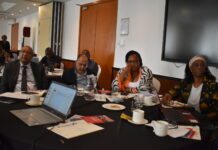By Clifford Akumu
Prevention and treatment of HIV in infants and children are set for a major boost after Kenya’s Ministry of Health launched the 3rd HIV Population-based HIV survey to be conducted across the 47 counties.
The survey that targets households countrywide comes hot on the heels of several years of scaling up HIV prevention, treatment, and care. The survey is also expected to assess how many people are currently infected with HIV, New infections and those on treatment.
Dubbed Kenya Population-Based HIV Impact Assessment(KENPHIA), the survey will look at the state of the HIV in Kenya and the impact of efforts towards epidemic control.
“The fight against HIV and its ravages cannot be won without understanding its impact on adolescents and children. The survey gives the country an opportunity to get information at the lowest level of primary care” said Dr. Rashid Asman, Chief Administrative Secretary at the Ministry of Health.
Mavens in Health reckon that a lot of work needs to be done in young and adolescents for the country to achieve an HIV free status by 2030. This comes on the backdrop of statistical estimates that indicate 53% of HIV infected persons are unaware of their HIV status.

Worse still, according to the Kenya HIV Estimates 2015 Report, there are 1.5 million people living with HIV in Kenya, and an estimated 35,800 deaths due to AIDS each year. Achieving globally endorsed 90:90:90 target, which aims to have:90% of all people living with HIV aware of their status, 90% of all people with diagnosed HIV on treatment, and 90% of people on treatment attaining viral suppression by 2020, Kenya needs to develop bigger, better and bolder responses.
“The data will have an impact on the lives of Kenyans especially infants and children. These outcomes serve as reminders that for the first time the global community has the opportunity to control the HIV/AIDS epidemic without a vaccine or a cure. The American Government will continue to support this trend of success to help ensure the sustainability of HIV service in Kenya” said Robert Godec the outgoing U.S. Ambassador to Kenya.
According to the Ministry of Health, the survey will also look at county specific status on HIV epidemic. It will also be the first time the country will get data on STIs, Hepatitis B prevalence as well as the nutrition status of children and pregnant mothers.
Dr. Jackson Kioko, Director Medical Services noted that data from the survey will facilitate the development of high impact interventions among Counties “KENPHIA will provide counties with the much-needed data to support planning, resource mobilization and programming of HIV interventions” said Kioko.
Dr. Peter Cherutich, Head of Directorate of Preventive and Preventive health noted the
government will use the data to inform policy decisions and resource allocations processes.“It will provide a more precise way to define and understand our HIV epidemic,” said Cherutich who is also the Principal Investigator in the survey.
Cherutich also noted that the six-month survey is funded to the tune of 1.5-2billion US
dollars by the U.S Centers for Disease Control and Prevention(CDC) and support from
other countries.

Peter Young, an Epidemiologist at the Division of Global HIV and TB at CDC noted there was lack of precise data on HIV/Aids drug resistance in the country.
“We are working towards including this data during the survey,” said Young.
Participants in the survey are expected to get free HIV testing and counseling in the privacy of the homes. It will also include other tests to assess disease progression or treatment response for people who already know their status.
“We have been involved in community mobilization and we hope Kenyans will take part in the survey” said Cherutich.
Head of the National AIDS and STI and Control Program (NASCOP) Dr. Kigen Bartilol noted that “The survey will involve 36,000 randomly selected individuals between ages of 0-64 years in the voluntary exercise”.
KENPHIA is part of the Population-based HIV Impact Assessment Project, a five-year, multi-country household initiative that will collect information related to HIV in 15 African countries.
Already 8 countries have completed the survey including Swaziland, Zimbabwe, Zambia, Malawi, Lesotho, Tanzania, Uganda, and Namibia while data collections are currently ongoing not only in Kenya but also in Cameroun, Cote D’Ivoire, and Ethiopia.














